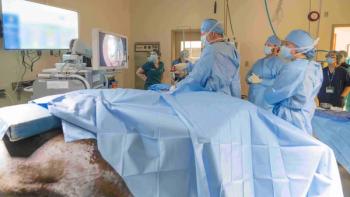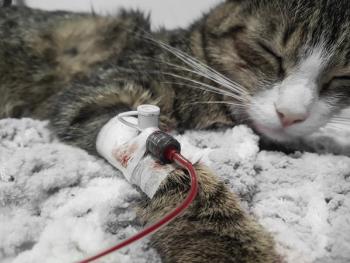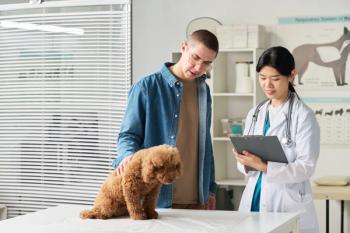
Basic lameness diagnosis of dogs (Proceedings)
Lameness is defined as a variance from normal gait. There are two types of lameness: anatomical and pathologic. Anatomical lameness may not necessarily be from pain, and can be genetic or acquired. Chondroplasia in the Alaskan Malamute is a genetic condition that would produce lameness.
Lameness is defined as a variance from normal gait. There are two types of lameness: anatomical and pathologic. Anatomical lameness may not necessarily be from pain, and can be genetic or acquired. Chondroplasia in the Alaskan Malamute is a genetic condition that would produce lameness. An example of an acquired lameness would be rickets as a result of a Vitamin D, calcium, or phosphorus deficiency. Pathological lameness can be neural or musculoskeletal. Cauda equina lesions are an example of a neural lameness. Musculoskeletal lameness is usually caused by pain.
It is important to understand that if any joint is affected it will affect the rest of the dog's structure. This applies to any joint lameness or joint restriction that we may apply. It is important to address and repair any lameness as soon as possible. When possible it is also important to select a treatment and/or therapy regimen that returns the structure to normal movement as soon as possible. The longer the movement of any joint is restricted, the more it affects the rest of the body. Although this applies to all pet dogs, these issues are magnified in the athletic and working dog.
Palpation basics
Physical palpation can be used to determine location of any primary, secondary, and/or tertiary pain associated with lameness or a drop in performance. Canine palpation is an art and gets easier with experience. Try to be consistent during the manipulation. This allows for left and right comparisons. Understand musculoskeletal anatomy and remember the body should be symmetrical. If the technique is consistent and there is variation between the left and right side the deviation should be documented.
The examination should be performed in an environment comfortable to the dog. The surface of the examination location should allow the dog to walk around without slipping. This helps to eliminate any fear associated with falling or slipping. Begin the examination by discussing the history with the owner. This allows the dog time to acclimate to the setting and helps to put the owner at ease. Allow the dog to approach on its own. Getting down on the dog's level will be less imposing to the dog and their curiosity will bring them towards the examiner for an investigation. Once the dog feels comfortable, begin to pet the dog and stand up for the examination.
Begin the examination by standing over the dog while stroking its back. This is done to assess body symmetry and any back pain. After the vertebral assessment move to the head and neck. The occipital-atlantal joint is analyzed by placing the index finger and the thumb on the wings of the Atlas vertebral bone and using the other hand to flex and extend the joint up and down and to the left and right. Next one hand is placed upon the dorsal points of the Scapula and the neck is flexed and extended up and down and to the left and right.
The appendicular skeleton is always analyzed beginning distally and then move proximally. Start with a sound leg first. This allows the examiner to assess how the dog is going to respond to normal palpation. Responses elicited on the other legs can then be referenced to the responses of the normal leg. Begin by assessing the pads and webbing. Then flex and extend each phalangeal joint. Special attention should be paid to the sesmoids. These are a common problem in athletic and working dogs. The second and seventh sesmoids of the front paws are the ones most commonly affected. Palpate the long bones and soft tissue structures of the foot and then move proximally to the carpus if palpating the front leg. The joint should be flexed and extended and then stressed medially and laterally. Palpate the long bones and soft tissues of the antebrachium and then move proximally to the elbow. Flex and extend the elbow joint, stress it medially and laterally, and then rotate clockwise and counterclockwise. Palpate the long bones and soft tissues of the brachium and move proximally to he shoulder joint. It should be flexed, extended, and then brought up to the flank. The back legs should be examined in a similar manner, working distally to proximal.
Helpful hints
Once any neurological problems have been ruled out, it is helpful to remember that there are only five tissues that can create lameness in the leg of a dog. These tissues are muscle, bone, tendon, ligamentous/synovial, and skin. The skin can be assessed by visualization and by palpation. Feel free to use the clippers at sites of question. Always palpate the paw pads. This is one common cause of lameness that is easily overlooked. Radiographs and palpation can assess Bones. Acute muscle injuries usually get better after 3-5 days. If lameness is present for longer than that, in general muscle problems can be ruled out. Most tendon problems are in the distal extremities and can be found through palpation. Once these tissues are ruled out, the ligaments and synovial structures should be re-palpated once while the dog is awake and then while sedated.
Always move from distal to proximal when examining the appendicular structures. This eliminates errors in the diagnostic work-up. For example, if the elbow is assessed before the carpus it is possible to erroneously diagnose a carpal problem as an elbow problem. While palpating the elbow one hand is placed on the carpus. The pressure applied to the carpus by the hand can create a pain that is mistaken for elbow pain. This mistake would not occur if the carpus were palpated first.
Note all findings in the dog's record, and then discuss these findings with the owner or handler to determine which are significant. Problems that would not be significant in the normal pet dog could be creating a problem in the athletic or working dog.
References
Eward, C. Gillette, R. Eward, W (2003) Effects of unilaterally restricted carpal range of motion on kinematic gait analysis of the dog, authored by. in Veterinary and Comparative Orthopaedics and Traumatology. Schattauer GmbH,Stuttgart, Germany 16: 3, 158-163.
Gillette, RL (2003) The Most Important Muscles of Performance, The Athletic & Working Dog Newsletter 2:2 (1-3)
Gillette, RL (2004) The Affect of Joint Movement Alterations on Dog Locomotion. The Athletic & Working Dog Newsletter 3:6 (1-4)
Gillette, RL, Zebas, CJ (2003) Performance of the Canine Athlete. The Athletic & Working Dog Newsletter 2:3 (1-4)
Newsletter
From exam room tips to practice management insights, get trusted veterinary news delivered straight to your inbox—subscribe to dvm360.




